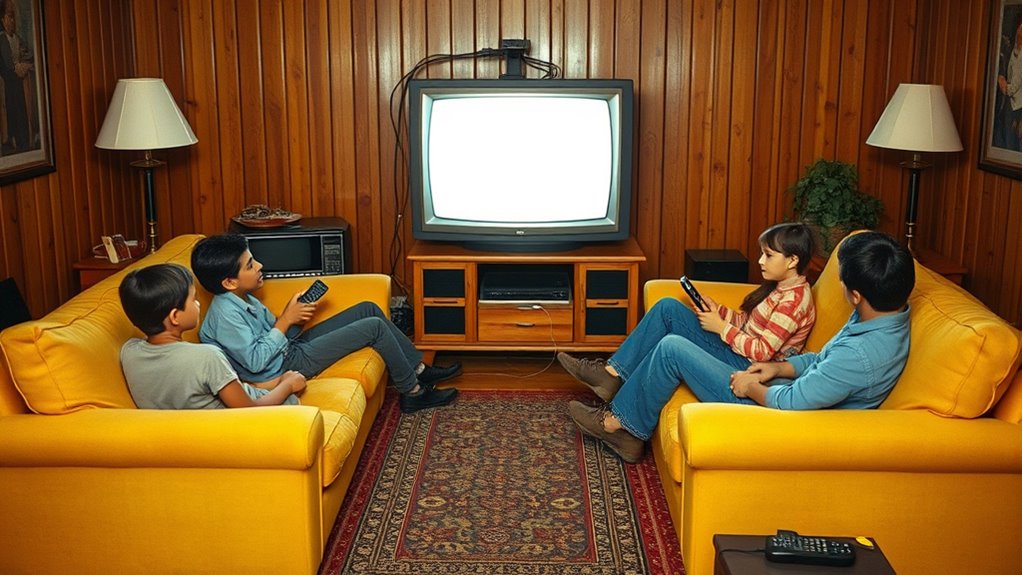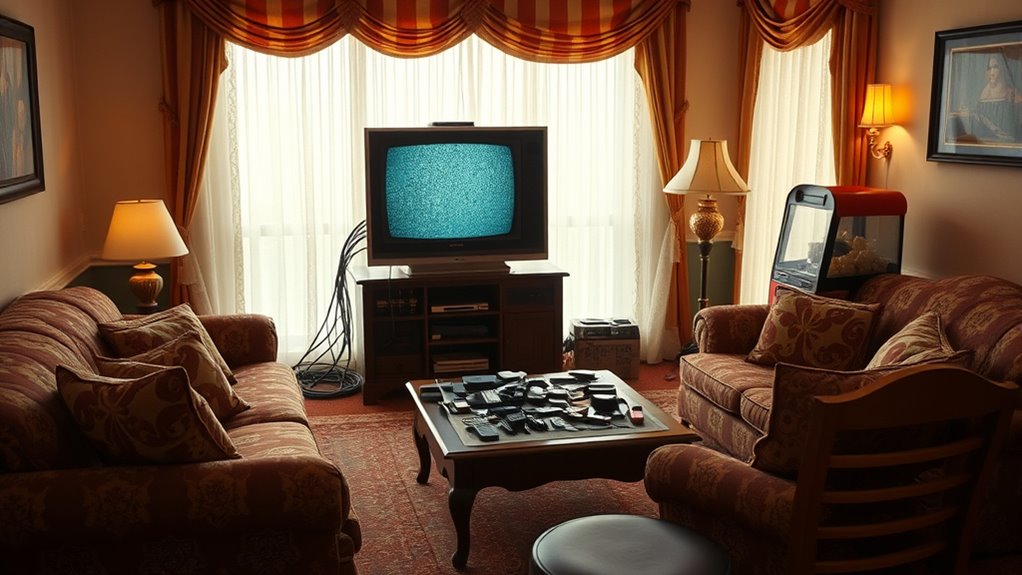The cable TV revolution shifted how you watch by offering personalized, on-demand options instead of scheduled broadcasts. This change made it easier for you to be a couch potato, with the ability to choose what to watch anytime and interact through live polls or multiple camera views. As TV became more flexible and tailored to your preferences, passive viewing turned into a more immersive experience. Keep exploring, and you’ll discover how this shift shaped your modern entertainment habits.
Key Takeaways
- The rise of on-demand streaming shifted viewers from scheduled broadcasts to passive, binge-watching habits, fostering the “couch potato” culture.
- Traditional cable’s rigid packages limited personalization, encouraging prolonged sedentary viewing without active engagement.
- Advancements in home technology made prolonged TV time more immersive and comfortable, reinforcing passive consumption.
- The decline of cable TV’s dominance led to more individualized, less interactive content, promoting sedentary entertainment habits.
- Personalized recommendations and easy access to content encouraged viewers to stay passive and couch-bound for extended periods.

The Cable TV Revolution has transformed how you access entertainment, shifting from traditional broadcast methods to a vast array of channels and on-demand content. This shift has fundamentally changed your viewing experience, making it more personalized and flexible. Instead of tuning in at scheduled times, you can now choose what to watch whenever it suits you. Interactive viewing has become a key part of this revolution, allowing you to engage with content in ways that weren’t possible before. You can participate in live polls, choose different camera angles, or access additional information about shows right on your screen. This level of interaction keeps you more involved and enhances your overall experience, making TV viewing more immersive than ever.
At the heart of this transformation are the new subscription models that have replaced traditional cable packages. Instead of paying a fixed, bundled price for hundreds of channels you rarely watch, you now have the option to subscribe to specific streaming services or channels that match your interests. This flexibility means you’re in control of what you pay for, often resulting in lower costs and less clutter. These models also encourage content providers to produce higher-quality, niche programming since they can target specific audiences more effectively. You might subscribe to a service for your favorite sports, a streaming platform for binge-worthy series, or a channel dedicated to documentaries—tailoring your entertainment experience to your preferences.
Choose personalized streaming services for greater control, better quality, and tailored entertainment options that suit your interests.
This shift to subscription-based services has also led to the rise of on-demand content. No longer are you bound by the schedules of traditional TV broadcasts. Instead, you can access entire seasons of shows, movies, or special events whenever you want. This convenience has turned passive watching into a more active, intentional activity. You’re the one choosing what to watch, when to watch it, and how to watch it. Many platforms even offer personalized recommendations based on your viewing history, making it easier to discover new favorites. Additionally, advancements in projector technology are making home viewing setups more immersive, allowing you to enjoy high-quality visuals right in your living room.
The cable TV revolution has fundamentally made TV a more customizable and interactive experience. You’re no longer a passive observer but an active participant in your entertainment journey. Thanks to innovative subscription models and interactive viewing options, you’ve gained unprecedented control over your content. This evolution has led to the decline of traditional cable’s dominance and the rise of a new era where your preferences shape your TV experience. It’s clear that this revolution has not only changed how you watch but also how you engage with media, transforming you from a passive couch potato into an empowered viewer.
Frequently Asked Questions
How Did Cable TV Influence Traditional Broadcast Networks?
You see, cable TV changed traditional broadcast networks by offering more channels and better picture quality. This shift meant networks had to compete with cable’s pay-per-view options, especially in sports broadcasting, which attracted viewers with live events. As cable grew, networks lost some audiences and advertising revenue, forcing them to adapt. Your viewing choices expanded, but it also challenged the dominance of traditional broadcasters in the evolving television landscape.
What Technological Advancements Enabled the Rise of Cable TV?
Imagine the moment when advances in cable infrastructure unexpectedly transformed your entertainment. Technological breakthroughs like improved signal transmission enabled cable TV to reach homes more reliably and with better quality. These innovations, including coaxial cables and fiber optics, allowed for clearer signals and more channels. As a result, you gained access to a wider variety of programming, making cable TV a revolutionary force that reshaped how you watch and enjoy entertainment.
How Did Cable TV Impact the Advertising Industry?
You see, cable TV changed the advertising industry by offering targeted ads based on viewership demographics. This shift allows you to reach specific audiences more effectively, tailoring advertising strategies to different age groups, interests, and lifestyles. As a result, advertisers can maximize their impact, increasing engagement and sales. The ability to customize campaigns based on detailed viewer data transformed how brands connect with consumers in the cable TV era.
What Were the Major Challenges Faced by Early Cable Providers?
You faced major challenges as early cable providers, especially with establishing subscription models that convinced customers to pay regularly. Regional restrictions also posed hurdles, limiting where you could offer your services and complicating expansion. These obstacles required innovative solutions to grow your audience and revenue, ensuring you could deliver diverse content despite regulatory and financial barriers. Overcoming these issues was vital for the cable industry’s success and evolution.
How Has Cable TV Evolved With the Advent of Streaming Services?
Remember how the golden age of TV feels like a distant memory? Today, streaming services have transformed your viewing experience, making it more personalized. But this shift brings cord cutting and content fragmentation, leaving you juggling multiple platforms. You gain freedom, yet lose the simplicity of cable TV. As you navigate this digital maze, you realize that evolution offers both opportunity and challenge in your quest for the perfect binge.
Conclusion
As you settle into your couch, cable TV quietly rewrote the story of entertainment, turning viewers into explorers of endless worlds. It transformed your living room into a universe of possibilities, where every channel is a new adventure waiting to unfold. The couch potato wasn’t born by accident; it was shaped by this revolution, making your comfort the gateway to a boundless galaxy of stories. In this new world, you’re both spectator and voyager.









